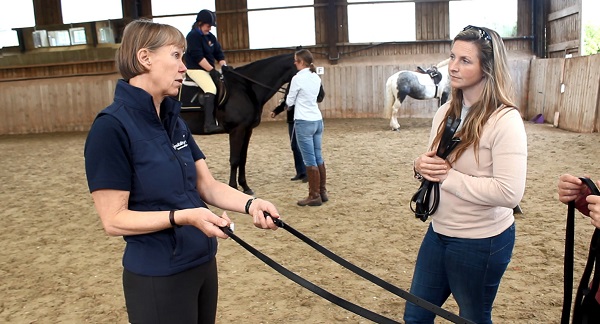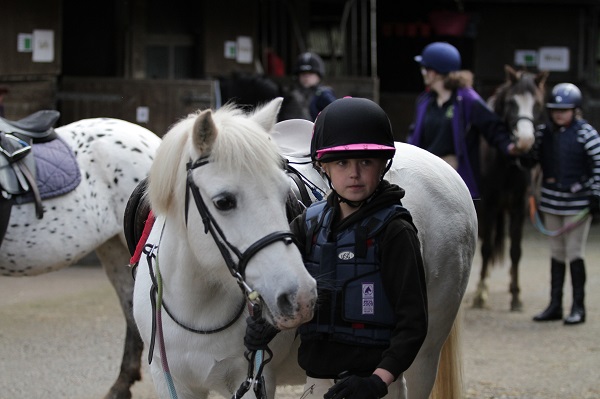Posted: 31st October 2018 | Back to news feed
Lizzie Hill has been involved with the Accessibility Mark scheme from its very foundation, turning a revolutionary idea to provide training to commercial equestrian centres, to enable them to confidently teach disabled people to ride, into reality. Here Lizzie explains what makes a good Accessibility Mark Centre.
As the pilot project has grown into a successful nationwide scheme, Lizzie is now Accessibility Mark’s most experienced Accessibility Mark Officer (ASO), travelling the country to provide training and assessment to centres that apply for the accreditation.

There are many misconceptions about disabilities and Accessibility Mark is helping to break down barriers and establishing an inclusive environment for disabled people to participate in sport.
Part of Lizzie’s role is to challenge these misconceptions within equestrian centres to help them understand what can be achieved. But what are the elements that come together to make a good Accessibility Mark centre?
“It is really important to understand that no two centres are alike, which we were very aware of when setting out the criteria for Accessibility Mark, but at the same time there needed to be a certain standard upheld in order to be associated with RDA.” said Lizzie.
The main stipulations to meet the criteria are that instructors are qualified; that facilities fall within set guidelines; the centre must be affiliated with The British Horse Society, The Pony Club or The Association of British Riding Schools; and they must hold a valid riding school licence from their local council.
When centres are going through the application process, the aim of the ASO is to provide support rather than for the centres to feel they are being judged on their suitability.
Centres often assume that their facilities will not meet the guidelines if they are not fully accessible to wheelchair users, but limiting factors would not rule a centre out for accreditation. It is up to individual centres to decide the level of disability that they can work with.
“A centre may not have the resources, space or wish to install a mounting ramp, but if they have other suitable mounting facilities for riders who can manage to walk up steps, this would still enable them to achieve their accreditation.” explained Lizzie.
“We record which centres are able to take riders who have limited mobility and require a ramp and this helps us provide the best possible service to riders by helping them choose the most appropriate place to learn to ride.”
Without a doubt the horses are the most important factor in whether a centre can achieve Accessibility Mark status, however, there is no such thing as the perfect RDA or Accessibility Mark horse.
“When assessing the horses I look for genuine all-rounders and work with the centre to look at the characteristics of their current equine workforce. It is important to give the instructors confidence that a lot of the challenges that the horses may face with riders with disabilities are no different to that of any range of riding school clients.”
During a practical training session, the ASO will work with instructors and helpers and three or four of the centre’s horses, going through different mounting techniques, leading and side walking and getting them used to a range of unpredictable behaviour.
“It is often during this training that staff are surprised and pleased at how versatile the horses are.” added Lizzie.
The backbone of most successful centres is its team of volunteers and Lizzie encourages all centres to try and establish a group of helpers, who all have to undergo the compulsory training, to assist in the preparation and delivery of Accessibility Mark sessions.
A good centre is one that embraces the fact that Accessibility Mark sessions may take a little longer and seeks to create a rapport with existing clients by asking them to support riders riding under the Accessibility Mark banner.
How centres run their Accessibility Mark sessions is entirely up to them but an open- minded approach is key to making the scheme work, with some having dedicated sessions while others integrate Accessibility Mark clients into their existing groups.
Said Lizzie: “I find that instructors are nervous of doing or saying the wrong thing but once reminded that they should teach what they see in front of them and as long as appropriate rider history is sought, the session should be run just as any other lesson.”
“A good relationship between the centre and its ASO, with open dialogue, is essential to making sure clients gain maximum benefit.”
“Asking for help and guidance on lesson planning and progression helps staff to focus on the individual needs of the rider to achieve their goals, whether it is a therapeutic rider or a rider with ambitions to compete.

“A willingness to work with local RDA Groups is also beneficial to ensure riders get the best possible experience, as some riders will be better suited to a dedicated RDA Group while others will excel in an Accessibility Mark session.
“It is so pleasing to hear of riders that have been waiting on the RDA group waiting list now happily riding regularly at an Accessibility Mark centre. We just aim to achieve more of these successes.” said Lizzie.
The Riding for the Disabled Association (RDA), in partnership with the British Equestrian Federation (BEF), launched the revolutionary Accessibility Mark scheme to work with riding centres with the aim of opening up more opportunities for disabled people to participate in riding.
There are currently 52 Accessibility Mark-approved centres across the country.
To find your nearest RDA Group or Accessibility Mark centre visit www.rda.org.uk
The Equestrian Index newsfeed is compiled from articles submitted by advertising members and expresses the opinions of those members. Watsons Directories Ltd shall not be held liable for any inaccuracies or mis-statements therein.
